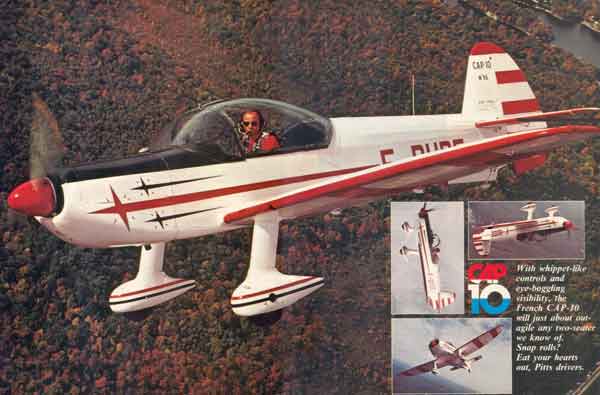
 |
PAGE THREE When I first climbed into the cockpit with Daniel I was struck with a feeling of starkness or Spartanism. I can't really explain that feeling, since the only thing more stark than my Pitts is a jungle gym. I think I expected the interior to have the same soft flowing lines the outside has. The more I flew the airplane, the more I realized that what I was seeing was a cockpit laid out for function, not looks. Even though the instrument placement would be classed as early-pinball, the rest of the controls are nicely located, almost unique in some respects. The starter, mags, and fuel selector, for example, are on a small console under the panel and a little flap on the fuel selector covers the starter button when the fuel is in an "off" position. You can't start it with the fuel off. Now, that smacks of Yankee ingenuity. Why, then, hasn't some Yankee done the same thing? One of the things contributing to the feeling of functionalism is that the control system torque tubes are mounted above the floor. All airplanes have the same type of thing, but we're just not used to seeing them. The sticks themselves have weird little rubber grips with all sorts of protrusions sticking out of them so you feel like you're holding hands with a porcupine. It felt strange in the beginning, but the first time I jammed the stick forward and negative Gs tried to pull my hand oft the stick, I began to really appreciate the design. One of the dumbest things we do in aviation is force everybody to fly with the left hand and operate the go lever with the right. Apparently the French feel the same way because the CAP 10 has two throttles, one in the normal location and the other on the lett side so both pilots can fly with their right hands on the stick if they want. It makes sense to use the hand you are most dexterous with on the controls and in the CAP you can use either hand on the stick and still have a throttle where you want it. Probably the biggest vote of confidence given the CAP 10 was the relatively casual way in which Daniel turned over one of his plywood G-machines to me to use in instruction. It's one thing to let a pilot fly your airplane, it's something entirely different to let him use it to teach someone else how to fly. That means he is letting you deliberately expose his machine to the mistakes of students, knowing that the airplane will give you plenty of time to save the day. Oh yes, he did give me a checkout, or rather he rode along and gritted his teeth while I abused the daylights out of his airplane. I'll have to admit to a case of overwhelming apathy towards the CAP 10 prior to my checkout. I guess maybe I'm a result of the American tendency toward visual overkill, but the CAP didn't, and still doesn't, look like it's a first-class acrobatic machine. As a matter of fact, during the checkout I was a little hesitant to push too hard. But, at Daniel's urging, I started poking further and further into the aerobatic innards of the CAP's wooden soul. And the harder I flew, the more I came to realize that this church mouse of an airplane only shows its tiger stripes if you force it to. You could fly it for a hundred years and never know that you were sitting in a Plexiglass bubble that would turn you everyway but loose if you'd only ask it. The things that amazed me most about the airplane surfaced at the times I could contain myself no longer and I'd take the controls away from Noland and play for a bit. Dave, it turned out, had non-tumbling gyros and could take a lot more than I could. One time, for instance, he came steaming down out of a loop and was letting his speed build a little too fast. I didn't want to let all that beautiful airspeed go to waste, so I took the stick and kept the nose down while the speed built to 290 kph (about 175 mph). I sucked it up into a vertical roll, fully expecting to do the roll fine but run out of steam and fall out of the sky like a head of lettuce. Much to my surprise, the wings zipped around the horizon and when I squeaked to a halt and stepped on the rudder to hammerhead out, it obediently pivoted on the tailpost and pointed us vertically at the ground. Considering the power, the weight and the entry speed, I was more than impressed with the way the CAP pulled it off.
Another time I got a wild hair and slapped it over into knife edge, intending to do a knife-edge to knife-edge snap roll. I jerked the stick back, nailed left rudder and almost instantly saw stars. That little dude snapped around so fast that I had bounced my head off the side of the canopy. I hit it so hard that I screwed up the recovery while I was trying to sort my eyes out. Snap rolls are one of the most enjoyable maneuvers in the airplane. It does them the same, right or left (some airplanes only snap right), and breaks so cleanly and predictably it's almost frightening. And it stops the same way, bang, which is even more amazing. The instant you pop the stick forward, the airplane literally jerks to a halt as it stops rolling. I did them going up, down, crossways, half snaps, quarters, three-quarters. It would be great fun to ramble on and on about this |
||